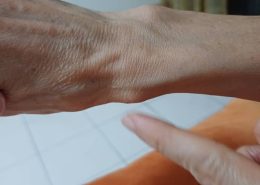I am 63 y/o female. I got this bump on my wrist for more than 2 weeks and it is very painful, feels hard and bony… is it bone spur? do I need to do x-ray?
Based on your description, it seems you are experiencing knee pain associated with physical activity, particularly during running. This could be related to several factors, including overuse, improper biomechanics, or early degenerative changes in the knee joint. Here’s a structured approach to undeRead more
Based on your description, it seems you are experiencing knee pain associated with physical activity, particularly during running. This could be related to several factors, including overuse, improper biomechanics, or early degenerative changes in the knee joint. Here’s a structured approach to understanding and managing your symptoms:
Possible Causes
1. Overuse Injury: Engaging in repetitive activities like running and sports can lead to stress on the knee joint, potentially causing conditions such as patellofemoral pain syndrome or iliotibial band syndrome.
2. Early Osteoarthritis (OA): Although less common in individuals in their 30s, early signs of OA can occur, especially if there are risk factors like previous knee injuries or a family history of OA.
3. Biomechanical Issues: Poor alignment or muscle imbalances can lead to increased stress on certain parts of the knee, contributing to pain.
Clinical Features to Consider
– Pain Location: Anterior knee pain often suggests patellofemoral issues, whereas lateral pain might indicate iliotibial band syndrome.
– Activity-Related Symptoms: Pain that worsens with activity and improves with rest is typical of overuse injuries.
– Swelling or Stiffness: These symptoms can indicate inflammation or joint effusion.
Diagnostic Approach
– Physical Examination: A thorough assessment by a healthcare professional can help identify specific areas of tenderness, range of motion limitations, or biomechanical abnormalities.
– Imaging: While plain radiographs can show joint space narrowing or osteophyte formation indicative of OA, an MRI might be required for a detailed view of cartilage and soft tissue structures.
Management Strategies
1. Activity Modification: Temporarily reducing high-impact activities like running can help alleviate symptoms.
2. Strengthening and Stretching: Focus on exercises that strengthen the quadriceps, hamstrings, and hip muscles, and incorporate stretching to improve flexibility.
3. Footwear and Orthotics: Ensure proper footwear for support and consider orthotics if there are alignment issues.
4. Pain Management: Use of NSAIDs or topical analgesics can provide symptomatic relief.
5. Physical Therapy: A physical therapist can tailor a program to address specific weaknesses or imbalances.
6. Weight Management: Maintaining a healthy weight reduces stress on the knee joints.
When to Seek Further Evaluation
– Persistent pain despite conservative measures.
– Significant swelling or instability.
– Difficulty performing daily activities.
Preventive Measures
– Gradually increase activity intensity to avoid sudden stress on the joints.
– Incorporate cross-training to balance muscle groups and reduce repetitive strain.
Conclusion
Given your active lifestyle, it’s important to address knee pain early to prevent further injury. Consider consulting a healthcare professional for a personalized assessment and management plan. Additionally, staying informed about proper exercise techniques and maintaining a balanced fitness regimen can help preserve joint health.
See less

In evaluating a painful, hard bump on the wrist, especially in a 63-year-old female, several possibilities could be considered, including a bone spur, ganglion cyst, or other bony or soft tissue abnormalities. Here’s a structured approach to assess and manage your condition: Differential Diagnosis 1Read more
In evaluating a painful, hard bump on the wrist, especially in a 63-year-old female, several possibilities could be considered, including a bone spur, ganglion cyst, or other bony or soft tissue abnormalities. Here’s a structured approach to assess and manage your condition:
Differential Diagnosis
1. Bone Spur (Osteophyte): These are bony projections that can develop along the edges of bones, often due to arthritis or joint degeneration. They can cause pain if they press on nerves or other structures.
2. Ganglion Cyst: Although typically softer, these fluid-filled sacs can sometimes feel firm and cause discomfort, especially if they press on nearby nerves.
3. Arthritis: Osteoarthritis or rheumatoid arthritis can lead to joint deformities or nodules that might feel hard and painful.
4. Other Bony Lesions: Less commonly, other bony growths or tumors could present similarly.
Recommended Evaluation
– Clinical Examination: A thorough physical examination by a healthcare professional can help differentiate between these possibilities based on the location, consistency, and mobility of the bump.
– Imaging:
– X-ray: This is a reasonable first step to evaluate bony structures and identify any bone spurs, fractures, or significant arthritic changes.
– Ultrasound or MRI: If the X-ray is inconclusive, these imaging modalities can provide detailed information about soft tissue structures, such as ganglion cysts or tendon abnormalities.
Management Considerations
– Conservative Treatment: Depending on the diagnosis, initial management might include rest, ice application, and nonsteroidal anti-inflammatory drugs (NSAIDs) to reduce pain and inflammation.
– Referral to Specialist: If the diagnosis is uncertain or if conservative management fails, referral to an orthopedic specialist or a rheumatologist might be necessary for further evaluation and treatment.
– Surgical Intervention: In cases where a bone spur or other lesion is causing significant pain or functional impairment, surgical removal might be considered.
Actionable Steps
1. Schedule an Appointment: See your primary care physician or a specialist for an evaluation.
2. Imaging: Discuss the need for an X-ray or other imaging studies to clarify the diagnosis.
3. Follow Medical Advice: Based on the findings, adhere to the recommended treatment plan, which may include medication, physical therapy, or further specialist referral.
Given your age and symptoms, it is important to address this promptly to prevent further complications and to ensure appropriate management.
See less